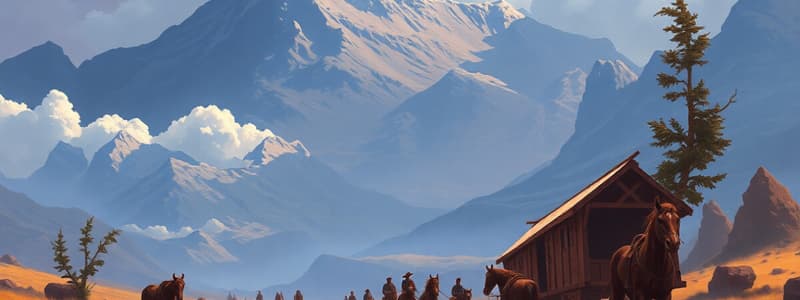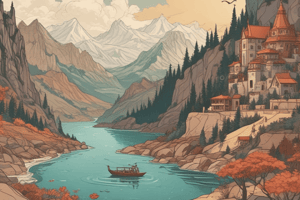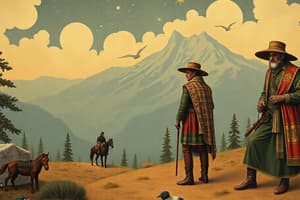Podcast
Questions and Answers
What was the primary destination for travelers on the Oregon Trail?
What was the primary destination for travelers on the Oregon Trail?
- Salt Lake City, Utah
- Sacramento, California
- Santa Fe, New Mexico
- The Willamette Valley, Oregon (correct)
From which city did the Oregon Trail officially begin?
From which city did the Oregon Trail officially begin?
- St. Louis, Missouri
- Council Bluffs, Iowa
- Independence, Missouri (correct)
- Walla Walla, Washington
What was the name of the belief that the United States was destined to expand across North America?
What was the name of the belief that the United States was destined to expand across North America?
- The Monroe Doctrine
- The American Dream
- Manifest Destiny (correct)
- Continental Divide
Which of the following was a common reason for people to travel the Oregon Trail?
Which of the following was a common reason for people to travel the Oregon Trail?
Which president oversaw the Louisiana Purchase?
Which president oversaw the Louisiana Purchase?
What was a major consequence of westward expansion for Native American tribes?
What was a major consequence of westward expansion for Native American tribes?
What was a common disease that caused death on the Oregon Trail?
What was a common disease that caused death on the Oregon Trail?
Which event significantly reduced the importance of the Oregon Trail?
Which event significantly reduced the importance of the Oregon Trail?
Which of the following trails branched off from the Oregon Trail?
Which of the following trails branched off from the Oregon Trail?
In what year did the first organized wagon party travel the Oregon Trail?
In what year did the first organized wagon party travel the Oregon Trail?
Flashcards
Manifest Destiny
Manifest Destiny
A belief that the United States was destined by God to expand its dominion and capitalism across the entire North American continent.
Oregon Trail
Oregon Trail
A 2,000-mile route from Independence, Missouri, to the Willamette Valley, Oregon, used by pioneers in the 19th century.
Louisiana Purchase
Louisiana Purchase
The acquisition of the Louisiana territory from France in 1803, which doubled the size of the United States.
Overland Trails
Overland Trails
Signup and view all the flashcards
Independence, Missouri
Independence, Missouri
Signup and view all the flashcards
Indian Reservations
Indian Reservations
Signup and view all the flashcards
Indian Appropriations Act of 1851
Indian Appropriations Act of 1851
Signup and view all the flashcards
Treaty of Ghent
Treaty of Ghent
Signup and view all the flashcards
Treaty of Oregon
Treaty of Oregon
Signup and view all the flashcards
Donation Land Claim Act of 1850
Donation Land Claim Act of 1850
Signup and view all the flashcards
Study Notes
- The Oregon Trail served as a route across the western frontier of North America.
- In 1836, the first organized wagon party traveled the 2,000-mile distance from Independence, Missouri, to the Willamette Valley, Oregon.
- Westward expansion motivated individuals to explore the American frontier and establish new lives in the West.
- Travelers on the Oregon Trail envisioned land with potential, open spaces, and freedom not available in the East.
American Expansion and Manifest Destiny
- Americans desired expansion from the time they first arrived in North America.
- In the early 1800s, Thomas Jefferson's Louisiana Purchase laid the groundwork for westward expansion.
- Jefferson acquired the Louisiana territory from France in 1803 which encompassed 828,000 square miles.
- States included in the Louisiana Purchase either entirely or in part: Louisiana, Iowa, Arkansas, Missouri, Oklahoma, Nebraska, North and South Dakota, Wyoming, Montana, Colorado, Minnesota, and Texas.
- President John Quincy Adams (1825-1829) facilitated the growth of the United States.
- Adams focused on expanding across the entire continent, rather than simply occupying lands devoid of European settlers.
- President James Polk annexed Texas with help from John O'Sullivan and won the Mexican-American War in 1848, gaining control of additional western states.
- Manifest Destiny fueled expansionism, the belief that the United States was destined by God to expand its dominion and capitalism across North America.
- Expansionism attracted many Americans seeking new opportunities and affordable land.
- William Walker attempted to invade parts of Mexico and Nicaragua after the Mexican-American War.
- Walker installed himself as president of Nicaragua for 10 months, but lacked the leadership and supplies and was forced out of power.
- He was captured and executed in 1860 in Honduras after his third attempt at filibustering.
- John O'Sullivan conceptualized Manifest Destiny, while William Walker attempted to implement it by force.
Claiming the Oregon Country
- In the early 19th century, the United States jointly owned the Oregon Territory with Britain.
- Great Britain relinquished claims to the Northwest Territory after the War of 1812 and Treaty of Ghent.
- By 1846, migration on the Oregon Trail made it clear that the Oregon country was rapidly becoming an American territory.
- Britain signed it over fully through the Treaty of Oregon.
Westward Expansion Trails
- Three main westward expansion trails were the Oregon Trail, the Mormon Trail, and the California Trail.
- Known collectively as the overland trails for the origin in the Midwest (Oregon and California Trails from Independence, Missouri, and the Mormon Trail from Council Bluffs, Iowa).
- The Oregon, California, and Mormon Trails followed a similar route, splitting in Wyoming and Idaho to head north or south.
- The California Trail led emigrants to areas such as Sacramento in Northern California.
- The Mormon Trail passed through Salt Lake City, Utah, and ended in Los Angeles, California.
- The Santa Fe Trail, originating in Independence, Missouri, crossed Kansas and New Mexico, ending in Santa Fe.
- Peak travel on the Santa Fe Trail occurred earlier (1820-1850) compared to the Oregon Trail (1843 to early 1850s).
History of the Oregon Trail
- The Oregon Trail and westward expansion were established in the early nineteenth century.
- Rudimentary trails were used primarily by fur trappers after the Rush-Bagot treaty of 1817.
- The treaty of 1817 established joint occupancy between Britain and the United States in the Oregon territory.
- Fur traders like John Jacob Astor recognized the potential of trapping in the West.
- After the Lewis and Clark expedition of 1804, Astor bought land in the Oregon Territory and named it Astoria.
- In 1836, missionaries Marcus and Narcissa Whitman traveled from St. Louis to the Walla Walla valley to preach to Cayuse Indians.
- Narcissa Whitman's letters encouraged other women to travel the trail with their families.
Purpose
- People traveled the Oregon Trail for economic opportunity, to avoid a cholera epidemic and economic depression in the Midwest.
- The Second Great Awakening inspired religious believers to preach to Native Americans or establish faith-based communities.
- Farmers were drawn by stories of fertile lands in the Oregon Country.
- The United States government offered free land in the Willamette Valley under the Donation Land Claim Act of 1850.
- Free land was offered to white men over 18 years of age until 1854, after which it cost $1.25 an acre.
Starting Point
- The 2,000-mile-long Oregon Trail officially started in Independence, Missouri.
- Independence, Missouri was the farthest point west on the Missouri River.
- Independence provided outfitters, wagon repair shops, and general stores for pioneers.
- The true starting point depended on the traveling family's origin, with many joining the trail from other mid-western cities.
The Journey
- Travelers often experienced hardships rather than adventure on the Oregon Trail.
- Most pioneers walked to reduce weight in their wagons and strain on the oxen.
- Young children, the elderly, and pregnant women sometimes rode in wagons.
- Emigrants started their journey in spring to avoid extreme temperatures.
- An exceptional day's travel ranged from 15-20 miles, with the total journey taking 5-6 months.
- Emigrants carried essential provisions like flour, sugar, salt, coffee, tea, bacon, dried beans, dried fruit, cornmeal, and rice.
- They also brought weapons to supplement their diet with wild game, along with a water keg, Dutch oven, and cooking utensils.
- Dangers included starvation, dehydration, gunshot wounds, accidents, drownings, weather, and occasional altercations with Native Americans.
- The most prominent cause of death on the Oregon Trail was disease, with the National Parks Service estimating that 10% of emigrants died from illness.
- Common illnesses included cholera, dysentery, mountain fever, measles, food poisoning, scurvy, smallpox, and pneumonia.
Ending Point
- Emigrants who survived the journey and stayed on the Oregon Trail typically arrived in Oregon City, Oregon, in late fall.
- Land grants were given in the Willamette Valley, Idaho, or Wyoming.
- Travelers encountered scenery, a lively town, and the promise of a new life.
Importance
- Of the 400,000 people who traveled west, approximately 80,000 ended up in Oregon.
- 50,000 during its peak years (1840-1860).
- The Oregon Trail established trade routes, explored undeveloped land, and provided new land for American settlers.
- Expansion undermined Native American tribes, leading to displacement.
- The Indian Appropriations Act of 1851 created the Indian Reservations system.
- Native Americans were forced onto designated tracts of land and restricted from leaving without permission.
- By 1890, the need to travel cross-country in a covered wagon had been eliminated.
- The first transcontinental railroad was completed in 1869, linking east to west.
Studying That Suits You
Use AI to generate personalized quizzes and flashcards to suit your learning preferences.




